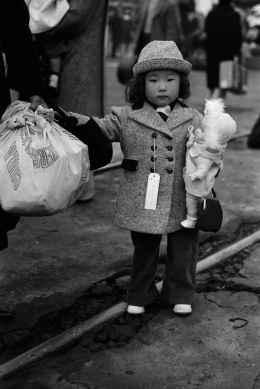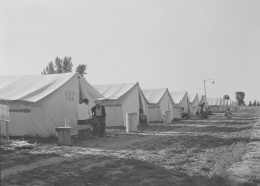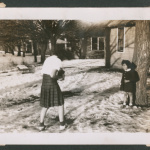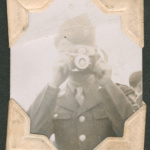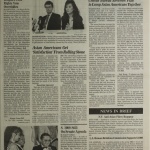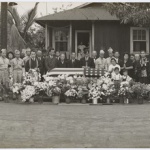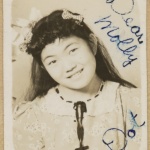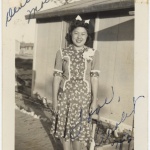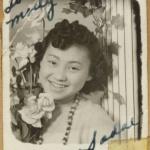Russell Lee
| Name | Russell Lee |
|---|---|
| Born | July 21 1903 |
| Died | August 28 1986 |
| Birth Location | Ottawa, Illinois |
Photographer Russell Lee (1903–86) is best recognized for his work with the Farm Security Administration (FSA). His photographic career extended from 1935 until his retirement in 1973. He worked for the largest federal documentary project in the history of the United States, and it was during this time that he documented several hundred images of the forced removal and confinement of Japanese Americans in the spring and summer of 1942.
Early Life
Russell Lee was born on July 21, 1903, in Ottawa, Illinois. His parents divorced when he was five years old and he lost contact with his father. In 1913, his mother died and for the remainder of his childhood Lee lived with different relatives, moving frequently. Such experiences instilled him a strong desire for place, which he later captured in his photography. [1]
In 1925, he earned a degree in chemical engineering from Lehigh University. Two years later he married Doris Emerick, a painter. His wife's involvement in the visual arts greatly influenced Lee as did the year the couple spent in San Francisco, where they become friends with artists Diego Rivera and Arnold Blanch. In 1931, the Lees moved to an artists' colony in Woodstock, New York. They spent the winters in New York City, taking painting classes. [2]
While his wife's painting skills were greatly improving, Lee's were not. In 1935, he purchased his first camera. Photography fascinated him, especially the technical aspects. He mixed his own chemicals, processed his own negatives, and experimented with flash. He began documenting poverty he encountered on the city streets. In the summer of 1936, Lee learned about the photographic work of a federal agency, the Resettlement Administration, in Washington, D.C. He assembled a portfolio and met with Roy Stryker, chief of the agency's Historical Section. A month later, Stryker gave him his first assignment, to photograph a housing project in New Jersey. Soon after, Lee was hired as a staff photographer. [3]
The Farm Security Administration
The Resettlement Administration was a New Deal agency established in 1935 to fight rural poverty through its rural rehabilitation programs. The Historical Section within the agency's Division of Information oversaw a documentary photography program that served to publicize the agency's efforts. From 1935 to 1944, the Historical Section produced approximately 175,000 black-and-white film negatives and 1,600 color photographs. In 1937, the agency changed its name to the Farm Security Administration (FSA) and it is under this name that its photographic work is best known. In October 1942 the photography program was transferred to the Office of War Information .
The photographers who worked for the FSA became some of the best known in the United States, including Dorothea Lange , Walker Evans, Arthur Rothstein, and Gordon Parks. Lee was the most prolific of the FSA photographers, producing more than 5,000 images during his tenure with the agency, yet his work differed greatly from his FSA colleagues. He produced series, while photographers like Lange and Evans were constantly seeking one great image. As a result, Lee's photographs were understated, as he carefully documented the scenes he encountered. Stryker described Lee as a taxonomist, who used his camera to document every element he saw. Lee's technical expertise also helped to separate him from the other photographers. While Lange and others favored natural light and rarely went inside buildings, Lee utilized direct flash to carefully record his subjects and the environments in which they lived. [4]
Lee's work for the FSA caused him to be on the road for long periods of time. The demands of his career led to the collapse of his marriage in 1938. Later that year he met Jean Smith and the two were soon married, forging a photography team. While Lee stayed behind the camera and managed the technical aspects of assignments, Jean wrote the captions that accompanied the photographs. By the early 1940s, the work of the FSA became nationally known and Lee was recognized as one of the agency's best photographers. [5]
Lee Documents Japanese American Incarceration
When the United States entered World War II, the Lees were working in California. After Stryker gained the necessary permissions from authorities in Washington, D.C., the couple began documenting the removal and confinement of Japanese Americans along the West Coast. Lee was greatly troubled by what he saw and believed in the importance of documenting this period of time, to have a record of the atrocities committed during wartime. [6]
Between April and August of 1942, Lee shot nearly 600 images of Japanese Americans in California, Oregon, and Idaho. His work began in Los Angeles County in April, where he photographed individuals and families making final preparations on their farms and businesses before their forced removals. He then photographed people with their luggage at the train stations en route to the Santa Anita Assembly Center as well as producing shots of the center. Like Lange's photographs for the War Relocation Authority , waiting was a common element in Lee's work in California—waiting for the next instructions from the government and waiting to board trains to be taken to temporary assembly centers.
The following month, he traveled north and documented the forced removal of Japanese Americans from San Juan Bautista and elsewhere in San Benito County as well as from Salinas. The themes in these series are similar—last minute preparations and then waiting. He also documented the Salinas Assembly Center .
His documentation of the Japanese American wartime experience was done in conjunction with his other assignments in California, as he and Jean continued to travel north through the state. Between June and July, he took four color photographs of Tule Lake before moving on to Oregon.
From July to August, Lee documented four Japanese American farm labor camps near the towns of Nyssa, Oregon and Rupert, Shelley, and Twin Falls, Idaho. Other photographers also documented such labor camps during the war, like the War Relocation Authority's Tom Parker , who captured images of Japanese American laborers in the sugar beet fields of Colorado, Montana, and Wyoming. But Lee stands alone in the breadth of his photographic record. Using his taxonomic approach, he produced series that showed the individuals and families residing in these camps, the living and working conditions they endured, and the recreational activities they engaged in, including visits to the nearby towns. Jean's accompanying captions helped better illustrate the situations in which these Japanese Americans found themselves. Recruited from assembly centers and concentration camps by representatives of sugar companies as well as the United States Employment Service, individuals and families volunteered to work in the sugar beet fields from Washington to South Dakota. Many lived in FSA tent and permanent camps that previously housed migrant workers, while others secured housing on private farms. Between 1942 and 1944, 33,000 Japanese Americans worked in seasonal farm labor outside of the WRA centers. Lee provided the largest collection of images documenting this aspect of the Japanese American wartime experience. [7]
Later Career
In early 1943, Lee left the agency to serve as a photographer in the Air Transport Command (ATC), where he documented airfields and routes for the remainder of the war. Between 1946 and 1947, he worked for the Department of the Interior on a medical survey of the bituminous coal industry. In 1947, the Lees moved to a small town just outside of Austin, Texas. For the next few years, Lee took on various photographic assignments, including working once again for Stryker, who was directing a photography program for Standard Oil of New Jersey. From 1965 until his retirement in 1973, he taught photography at the University of Texas-Austin. Russell Lee died on August 28, 1986, in Austin, Texas. Lee's wartime images are available online through the Library of Congress's Farm Security Administration/Office of War Information Collection.
For More Information
Archival Sources
Library of Congress. Prints & Photographs Division. Farm Security Administration/Office of War Information Collection. Black-and-White Negatives. http://www.loc.gov/pictures/collection/fsa/ .
Library of Congress. Prints & Photographs Division. Farm Security Administration/Office of War Information Collection. Color Photographs. http://www.loc.gov/pictures/collection/fsac/ .
Library of Congress. Prints & Photographs Division. Farm Security Administration/Office of War Information Collection. FSA-OWI Written Records, 1935-1946.
University of Louisville. University Archives & Records Center. Roy Stryker Papers, 1912-1972.
University of Texas at Austin. Briscoe Center for American History. Russell Lee Photograph Collection.
Books and Articles
Appel, Mary Jane. "Russell Werner Lee: The Man Who Made America's Portrait." In Russell Lee: A Centenary Exhibition . San Marcos, Texas State University: March 29-October 12, 2003.
Fleischhauer, Carl and Beverly W. Brannan, eds. Documenting America, 1935-1943 . Berkeley: University of California Press, 1988.
Hurley, F. Jack. Portrait of a Decade . Baton Rouge: Louisiana State University Press, 1972.
Hurley, F. Jack. Russell Lee, Photographer . Dobbs Ferry, NY: Morgan and Morgan, 1978.
Lee, Russell. "Pie Town." Creative Camera 193/194 (July-August 1980): 246-53.
Raeburn, John. A Staggering Revolution: A Cultural History of Thirties Photography . Chicago: University of Illinois Press, 2006.
Stryker, Roy Emerson and Nancy Wood. In This Proud Land . Greenwich, Conn.: New York Graphic society, 1973. Reprint. New York: Galahad Books, 1975.
Wroth, William, ed. Russell Lee's FSA Photographs of Chamisal and Penasco, New Mexico . Santa Fe, NM: Ancient City Press, 1985.
Young, Morgen. "Russell Lee in the Northwest: Documenting Japanese American Farm Labor Camps in Oregon and Idaho." Oregon Historical Quarterly 114.3 (2013): 360-364.
Online Resources
Modern American Poetry. "On the Way to the Camps: A Photo Essay." http://www.english.illinois.edu/maps/poets/g_l/haiku/photo.htm .
Oregon Cultural Heritage Commission. "Russell Lee in the Pacific Northwest." http://www.ochcom.org/Lee.html .
Oregon State Library. "Life on the Home Front: Oregon Responds to World War II." https://sos.oregon.gov/archives/exhibits/ww2/Pages/default.aspx .
Footnotes
- ↑ F. Jack Hurley, Russell Lee, Photographer (Dobbs Ferry, NY: Morgan and Morgan, 1978), 10-11
- ↑ Hurley, Russell Lee, Photographer , 12.
- ↑ Hurley, Russell Lee, Photographer , 13–15.
- ↑ F. Jack Hurley, "Russell Lee and the Roots of Photo-Humanism," paper for the Citadel Conference on the South, April 12, 1985.
- ↑ Hurley, Russell Lee, Photographer , 18-19.
- ↑ Author interview with F. Jack Hurley, August 2, 2013, Cornelius, North Carolina.
- ↑ Louis Fiset, "Thinning, Topping, and Loading: Japanese Americans and Beet Sugar in World War II," Pacific Northwest Quarterly 90.3 (Summer, 1999), 123.
Last updated June 16, 2020, 8:56 p.m..

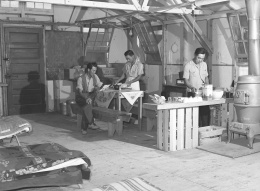 Media
Media
